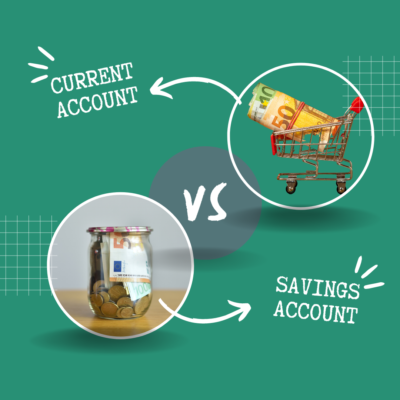In today’s fast-paced world, managing your finances efficiently is more important than ever. One of the first decisions you’ll need to make when opening a bank account is whether to open a savings account as well as a current account. This blog will guide you through the differences between the two, their benefits and drawbacks, and help you decide if having both is right for you.
Savings Account
A savings account is a type of bank account designed for saving money and accumulating interest over time. These accounts usually offer higher interest rates (although not great) compared to current accounts and are ideal for those who want to grow their savings.
Benefits
- Higher interest rates: Savings accounts typically offer higher interest rates than current accounts, allowing your money to grow over time.
- Minimal fees: Most savings accounts in Ireland have low or no fees, making them an attractive option for long-term saving.
- Encourages saving: Savings accounts are designed to encourage saving by offering incentives like higher interest rates and limiting withdrawals.
Drawbacks
- Limited accessibility: Savings accounts may have restrictions on the number of withdrawals you can make per month or require a minimum balance to be maintained.
- Lower liquidity: As a result of withdrawal restrictions, savings accounts may not be the best option for those who need immediate access to their funds.
Current Account
A current account is a type of bank account intended for everyday banking transactions, such as paying bills, receiving your salary, and making purchases. These accounts offer easy access to your money and various features but typically have lower interest rates than savings accounts.
Benefits
- Ease of access: Current accounts offer easy access to your money through online banking, ATMs, and debit cards.
- No withdrawal restrictions: Unlike savings accounts, there are no restrictions on the number of withdrawals you can make from a current account.
- Flexible banking: Current accounts often come with additional features like bill payment services, overdraft facilities, and the ability to set up standing orders and direct debits.
Drawbacks
- Lower interest rates: Current accounts generally offer lower interest rates compared to savings accounts, making them less suitable for long-term saving.
- Fees: Some current accounts in Ireland may charge fees for services such as overdrafts, ATM withdrawals, and foreign transactions.
Comparison
Interest Rates
Savings accounts usually offer higher interest rates, enabling your money to grow faster. However, current accounts provide easy access to your funds, making them more suitable for everyday transactions.
Fees
Current accounts may have more fees associated with them, while savings accounts typically have lower fees, making them more attractive for long-term saving.
Overdrafts
Overdraft facilities are often available with current accounts but are generally not offered with savings accounts.
Accessibility
Current accounts offer greater accessibility to your money, while savings accounts may have restrictions on withdrawals and require a minimum balance.
Purpose
Savings accounts are designed for short and long-term savings and accumulating interest, while current accounts are more suited for everyday banking transactions and easy access to funds.
How to Choose the Right Account?
Financial Goals
Consider your financial goals when deciding between a savings account and a current account. If you’re looking to grow your savings, a savings account with a higher interest rate may be more suitable. However, if you need easy access to your funds for daily transactions, a current account might be a better option.
Spending Habits
Evaluate your spending habits to determine which account is best for you. For example, if you tend to make frequent transactions, a current account with no withdrawal restrictions would be ideal. On the other hand, a savings account may be more appropriate if you’re trying to save money and limit your spending.
Required Services
Consider the additional services offered by each account type, such as overdraft facilities, bill payment services, and the ability to set up standing orders and direct debits. Then, choose the account that best meets your specific needs and preferences.
We hope this blog has helped you understand the differences between savings and current accounts in Ireland, and which one may be right for you. If you still have questions or need further assistance, don’t hesitate to reach out to us. Our team of financial experts is here to help you make the most informed decision for your unique financial needs.
Also, be sure to follow us on Facebook, Instagram, and LinkedIn for more helpful tips and insights on managing your finances.
FAQs
Can I have both a savings account and a current account?
Yes, you can have both a savings account and a current account to enjoy the benefits of each account type. This can help you manage your finances more effectively by allocating funds for different purposes.
Are my funds protected in Irish banks?
Yes, the Deposit Guarantee Scheme in Ireland protects deposits up to €100,000 per person, per institution.
Can I switch between a savings account and a current account?
Yes, you can switch between account types, but you may need to close one account and open another, depending on your bank’s policies.
Do all banks in Ireland offer the same interest rates?
No, interest rates can vary between banks and account types, so it’s essential to shop around and compare rates to find the best account for your needs.
Are there any tax implications for the interest earned on savings accounts?
Yes, interest earned on savings accounts in Ireland is subject to Deposit Interest Retention Tax (DIRT). The rate may vary depending on your individual circumstances, so it’s essential to consult a tax professional for specific advice.



